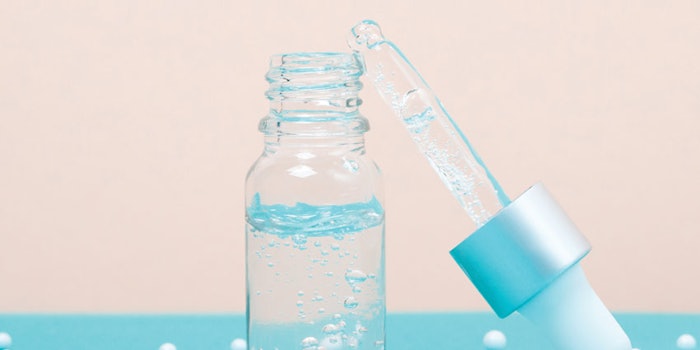
It’s funny how when it rains, we tease we must quickly find cover so we don’t “melt”—since we’re so sweet, we must be made of sugar; and obviously, sugar dissolves in water. What’s funnier is, there’s actually some truth to this, but let’s back up a moment…
Hyaluronic acid (HA), also referred to as hyaluronan, is a large polysaccharide; i.e., a carbohydrate such as a starch, cellulose or glycogen consisting of many (“poly”) sugar molecules bonded together—in some cases, several thousands of them.1 It reportedly was first discovered in 1934 by Karl Meyer and his assistant, John Palmer, in the vitreous of bovine eyes.1 As the story goes, the two isolated the substance from the eyes of a cow and found it to contain two sugar molecules, one of which was uronic acid. This, tacked onto the material’s source, i.e., the vitreous, “glass” part of the eye—or hyalos, in Greek—became what is now known as “hyaluronic acid.”1
As a naturally occurring material, HA serves various biological functions in a wide range of organisms, ranging from bacteria to higher animals, including humans. HA is found in most connective tissues but is especially concentrated around synovial joint fluid, vitreous fluid of the eyes and umbilical cord.1 It also is distributed widely throughout epithelial and neural tissues.2 This is why the rainstorm scenario rings true.
Biological Purpose and Uses
In vertebrate connective tissues and skin, HA serves a protective, structure-stabilizing and shock-absorbing role.3 According to WebMD, it cushions and lubricates the joints and other tissues, and may also affect the way the body responds to injury.4 In addition to lubricating and cushioning properties, HA demonstrates some in vitro anti-inflammatory activity and possible disease-modifying effects, which has prompted its investigation as a treatment for osteoarthritis and, to a lesser extent, rheumatoid arthritis.5
The unique viscoelastic (i.e., viscous and elastic) nature of HA, along with its biocompatibility and non-immunogenicity, has led to its use in a number of clinical applications. Examples include: supplementing joint fluid in arthritis; as a surgical aid for certain eye surgeries5—an application currently approved by the U.S. Food and Drug Administration;4 and to facilitate healing and tissue regeneration in wounds.3, 5
Hyaluronic acid also has been used as a lip4 and wrinkle filler for plastic surgery. And more recently, it has been investigated as a possibly drug delivery agent for various routes of administration, including ophthalmic, nasal, pulmonary, parenteral and topical.3
Topical Hydration and Antiaging
In reference to topical effects, HA is highly hygroscopic, meaning it tends to absorb moisture from the air, and this property is believed to be important for modulating tissue hydration and osmotic balance. In addition, it acts as a signaling molecule by interacting with cell surface receptors and regulating cell proliferation, migration and differentiation.1
In an interview with Allure,6 Santa Monica, California-based dermatologist Tsippora Shainhouse, M.D., explained how HA engages with water; based on its structure, HA can bind to collagen on one side and water on the other, which traps water in the skin and hydrates it. This makes the skin appear “fresh, full and bouncy,” Shainhouse said.
Cosmetic Approaches to HA
The same report underlines how, by better understanding the body’s metabolism of HA in different layers of the skin, the interactions of HA with other skin components could improve our ability to modulate skin moisture in a rational manner.7
This exploration of HA metabolism, along with its synthesis, is precisely the route being taken by Kao Corp., of Japan. As researcher Hiroyuki Yoshida explained, the company has been researching how to reinstate innate hyaluronan homeostasis in skin for anti-aging effects.8 He and co-authors also published work in the Journal of Cosmetic Dermatology9 describing how various plant extracts were screened for inhibiting HA degradation, among other effects, and Geranium thunbergii was identified as a promising material in vitro; it was found to inhibit HA degradation in skin fibroblasts.
Taking it a step further, the extract was formulated for application in a double-blind, randomized and placebo-controlled in vivo study. Twenty-one healthy Japanese women were recruited and each topically treated their faces on one side with a G. thunbergii lotion and the other, a placebo for a total of eight weeks. The extract showed improved anti-wrinkle activity and skin elasticity over the placebo.
From a different approach, cosmetic ingredient suppliers have devised ways to put HA back into skin. One company, for example, layered HA of various sizes and formats in a prototype formulaa to deliver the material back into skin at various skin depths.10 According to the company, starting from the skin surface, sodium hyaluronate crosspolymer, at 3.0 M Da, imparts a protective, dense film to reduce water loss and provide protection. Beneath this, two sodium hyaluronate ingredients of different sizesb, 1.3 M-1.8 M Da, and 0.2 M-0.4 M Da, are used to retain water on the skin surface and nourish the stratum corneum. A sodium acetylated hyaluronatec then firmly adheres to the stratum corneum, providing extra hydration and repairing the damaged corneum, then hydrolyzed sodium hyaluronated, < 10K Da, provides deep moisturization, repairing damaged cells and imparting antioxidant and anti-aging properties. Finally, a hydrolyzed sodium hyaluronate < 5K Dae penetrates into the epidermis and dermis, also hydrating and restoring the skin from the inside.
In the Spa
With its almost miracle-like ability to attract and bind water to the skin, it is no surprise that hyaluronic acid is a star in most hydrating skin care treatments—and spa treatments in general.
CIEL Spa at SLS in Los Angeles offers hyaluronic acid as part of its Second Skin Facial ($375), which is meant to serve as an alterative to facial fillers. In the facial, sterile electrospun hyaluronic acid skin patches by Biologique Recherche are custom fitted to the client’s unique trouble areas and massaged with serum until absorbed. The patches are said to hold 80% pharmaceutical grade hyaluronic acid to plump and smooth fine lines and wrinkles.
Eden Day Spa in San Anselmo, California takes a different approach with hyaluronic acid in its Hyaluronic Lifting Method ($750). This treatment employs infrared cold laser technology to transport hyaluronic acid deep into the skin.
Meanwhile, the Four Seasons Westlake Villiage in Los Angeles incorporates hyluronic acid into its Swift Lift Firming Facial (50/80 min., $205/285). After a facial analysis and deep cleaning, an exfoliating peel with natural fruit acids is them applied to remove dead skin cells. Following, algae-based peptides, hyaluronic acid and plants extracts are applied to firm and reduce the appearance of fine lines.
When it comes to products with hyaluronic acid, there is certainly no shortage in the professional skin care market. However, many of product manufacturers for the spa industry are taking hyaluronic acid to the next level, using it in unique forms and new combinations.
Sugar beets is where Pevonia went to source hyaluronic acid for its February launch, Hyaluronic Acid Hydra-Serum. With one of the highest hyaluronic acid concentrations on the market at 10%, the serum is able to deliver this ingredient thanks fragmented micro-particles, and hyaluronic acid is combined with marine collagen and Hibiscus esculentus extracts for extra hydrating and skin smoothing results.
If you are clients are thinking about injections but are a little hesitant, steer them toward BelleCote’s Wrinkle Erasing Serum with Hyaluronic Acid, which the company notes has the same myorelaxant properties as popular injectibles without the harsh ingredients or unpleasant side effects. The serum contains a hyaluronic complex to hydrate and plump the skin.
Sodium hyaluronate is used by Rhonda Allison it its Hyaluronic Serum, which helps skin retain moisture while also providing nutrients and removing waste from the cells. The result is soft, supple and hydrated skin.
DMK formulates with hyaluronic acid in its Hydrating Masque, where the ingredient restores hydration, prevents dehydration and improves wrinkles. The company notes that hyaluronic acid plumps the skin by restoring the interstitial fluid of the epidermis.
A serum is also the product form with hyaluronic acid for Skin Script with its The Ageless Skin Hydrating Serum. The product is said to improve hydration, balance surface lipids and lessen the appearance of wrinkles. This must-have serum also improves the health and quality of the cell membrane.
DermAware includes hyaluronic acid in a number of its products including its VITal B Hydrogel, which contains a high concentration of hyaluronates that can bind to excessive amounts of water. Peptides, vitamin B and rose are also included for plumping, anti-inflammatory and calming benefits. “Hyaluranic Acid is instantly recognizable and incorporated in our skin’s cellular matrix, making it not only natural in sourcing but natural to our biochemistry. The beauty is that the more you use this ingredient the better the results,” noted Gül Zone, CEO and founder of the company.
Skinprint included hyaluronic acid along with hemp seed oil, retinol and niacinamide in its new Total Repair Essences, available for all skin types and in an advanced formula. The essences use hyaluronic acid to hydrate the skin, while niacinamide improves skin tone, hemp nourishes and retinol diminishes the signs of aging.
Although we often think of our faces when it comes to hyaluronic acid, don’t forget about the feet. Baby Foot formulates with hyaluronic acid, collagen and 14 extracts to soften and smooth dry, cracked feet in its Moisturizing Foot Mask.
Conclusions
It appears that once again, the forces of nature are the ultimate engineer when it comes to biological design. Then again, they’ve had eons to experiment. It’s no wonder why we don’t melt in the rain.
References
- Necas, J., Bartosikova, L., Brauner, P. and Kolar, J. (2008). Hyaluronic acid (hyaluronan): A review. Veterinarni Medicina 53(8) 397-411; available at http://www.kalipura.it/download/Hyaluronic_acid.pdf.
- Wikipedia website (Accessed 2019, Nov 22). Hyaluronic acid. Available at https://en.wikipedia.org/wiki/Hyaluronic_acid.
- Brown, M.B. and Jones, S.A. (2005, Mar 31). Hyaluronic acid: A unique topical vehicle for the localized delivery of drugs to the skin. J Eur Acad of Derm. Available at https://onlinelibrary.wiley.com/doi/abs/10.1111/j.1468-3083.2004.01180.x
- WebMD website (Accessed 2019, Nov 22). Hyaluronic acid. Available at https://www.webmd.com/vitamins/ai/ingredientmono-1062/hyaluronic-acid.
- Goa, K.L. and Benfield, P. (1994 Mar). Hyaluronic acid. In: Drugs. New York: Springer. Available at https://link.springer.com/article/10.2165/00003495-199447030-00009.
- Baum, I. (2019, Feb 7). What is hyaluronic acid, and how does it benefit your skin? Allure. Available at https://www.allure.com/story/what-is-hyaluronic-acid-skin-care
- Papakonstantinou, E., Roth, M. and Karakiulakis, G. (2012, Jul 1). Hyaluronic acid: A key molecule in skin aging. Dermato-endocrinology 4(3). Available at https://www.tandfonline.com/doi/full/10.4161/derm.21923.
- Yoshhida, H. (2019, Apr 11). [video] Hyaluronan homeostasis for anti-aging effects. Cosm & Toil, available at https://www.cosmeticsandtoiletries.com/research/biology/video-Hyaluronan-Homeostasis-for-Anti-aging-Effects-508437881.html.
- Yoshida, H., Yamazaki, H.,…Takahashi, Y., et al. (2018, Nov 4). Inhibition of HYBID (KIAA1199)‐mediated hyaluronan degradation and anti‐wrinkle effect of Geranium thunbergii extract. J Cosm Derm. Available at https://onlinelibrary.wiley.com/doi/abs/10.1111/jocd.12813
- Grabenhofer, R. (2019, Apr 2). Leb demo layers HA for 4D skin benefits. Cosm & Toil. Available at: https://www.cosmeticsandtoiletries.com/formulating/category/antiaging/Lab-Demo-Layers-HA-for-4D-Skin-Benefits-508014581.html.
Footnotes:
a Hyacross (INCI: Sodium Hyaluronate Crosspolymer)
b Hyabloom HA-T and HA-TLM 20-40 (INCIs: Sodium Hyaluronate)
c Hymagic ACHA (INCI: Sodium Acetylated Hyaluronate)
d miniHA (INCI: Hydrolyzed Sodium Hyaluronate) and
e microHA (INCI: Hydrolyzed Sodium Hyaluronate) are products of Bloomage Biotech.
Rachel Grabenhofer is the managing editor of Cosmetics & Toiletries, Skin Inc.’s sister brand for cosmetic chemists. She’s a member of the Council of Science Editors and Society of Cosmetic Chemists, and for the past several years, has led judging panels to honor the best ingredients in cosmetics.











